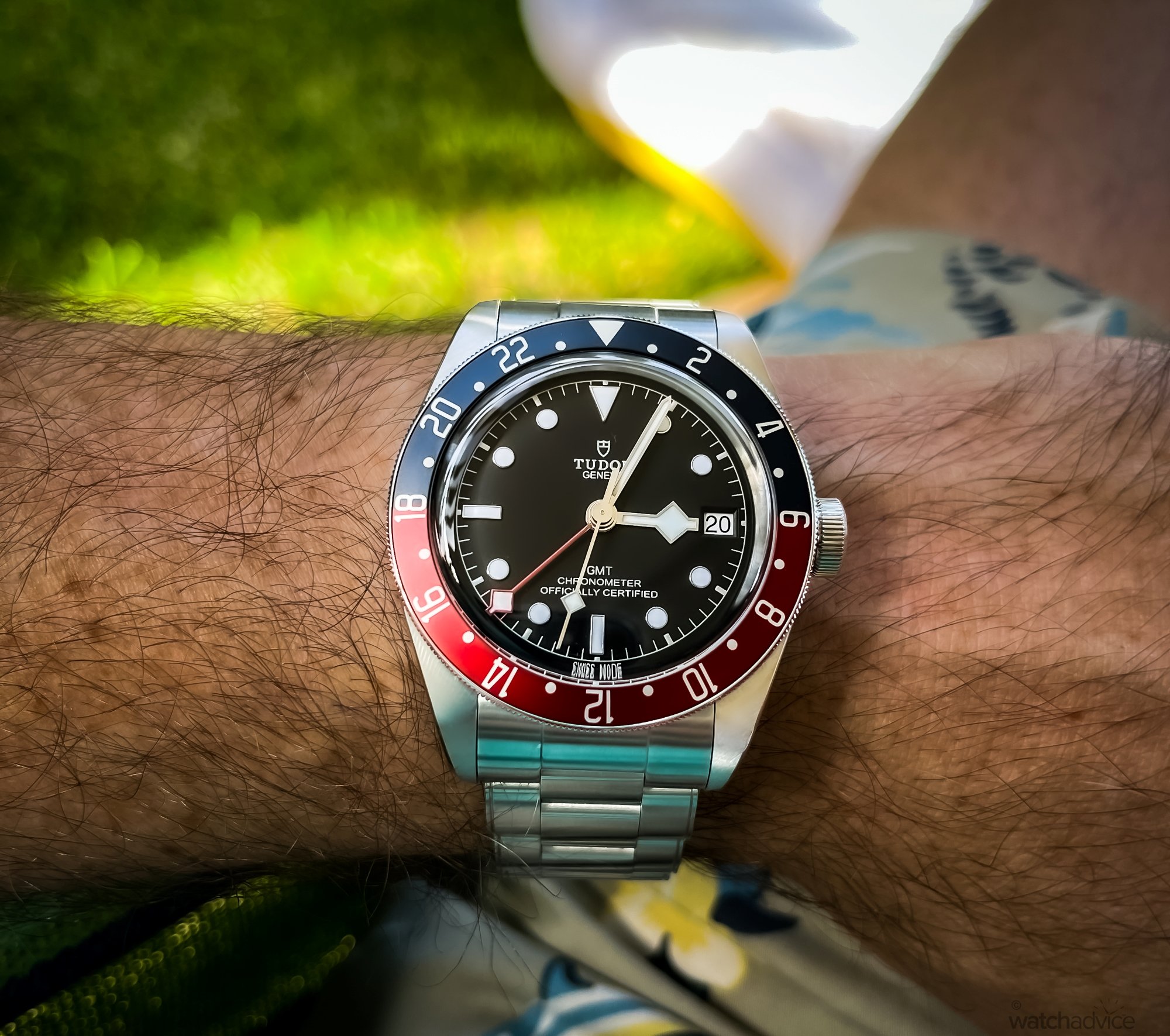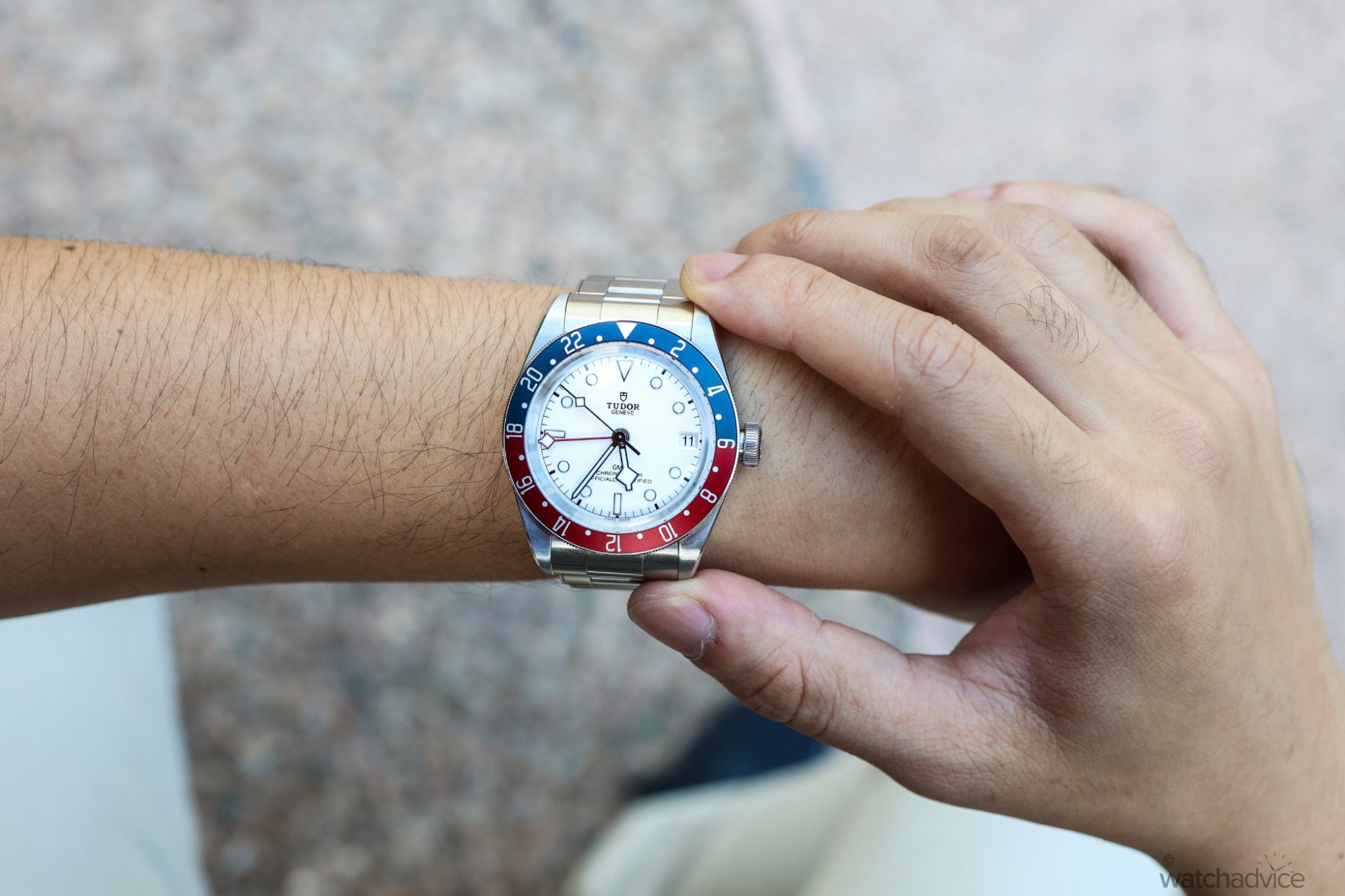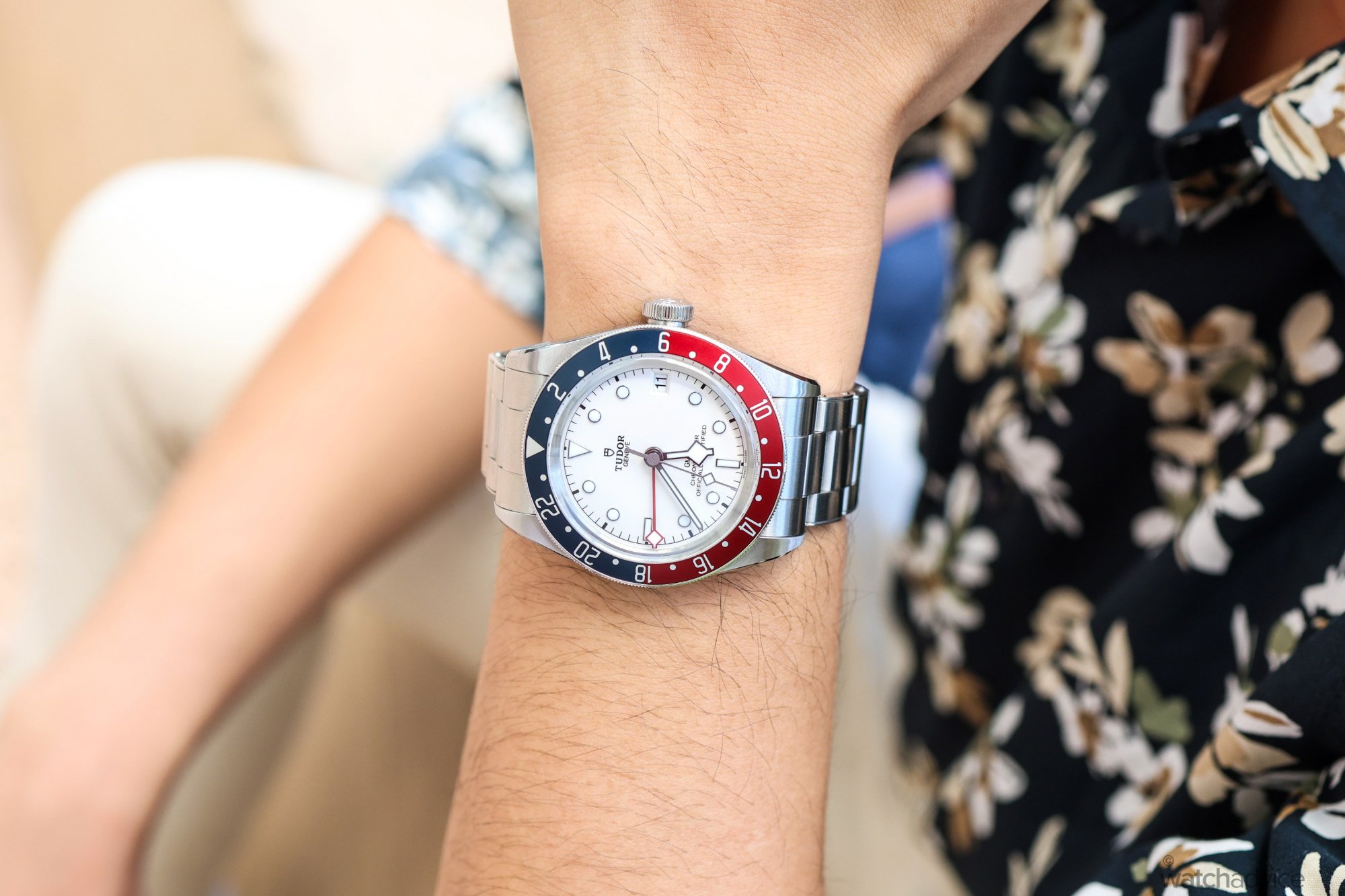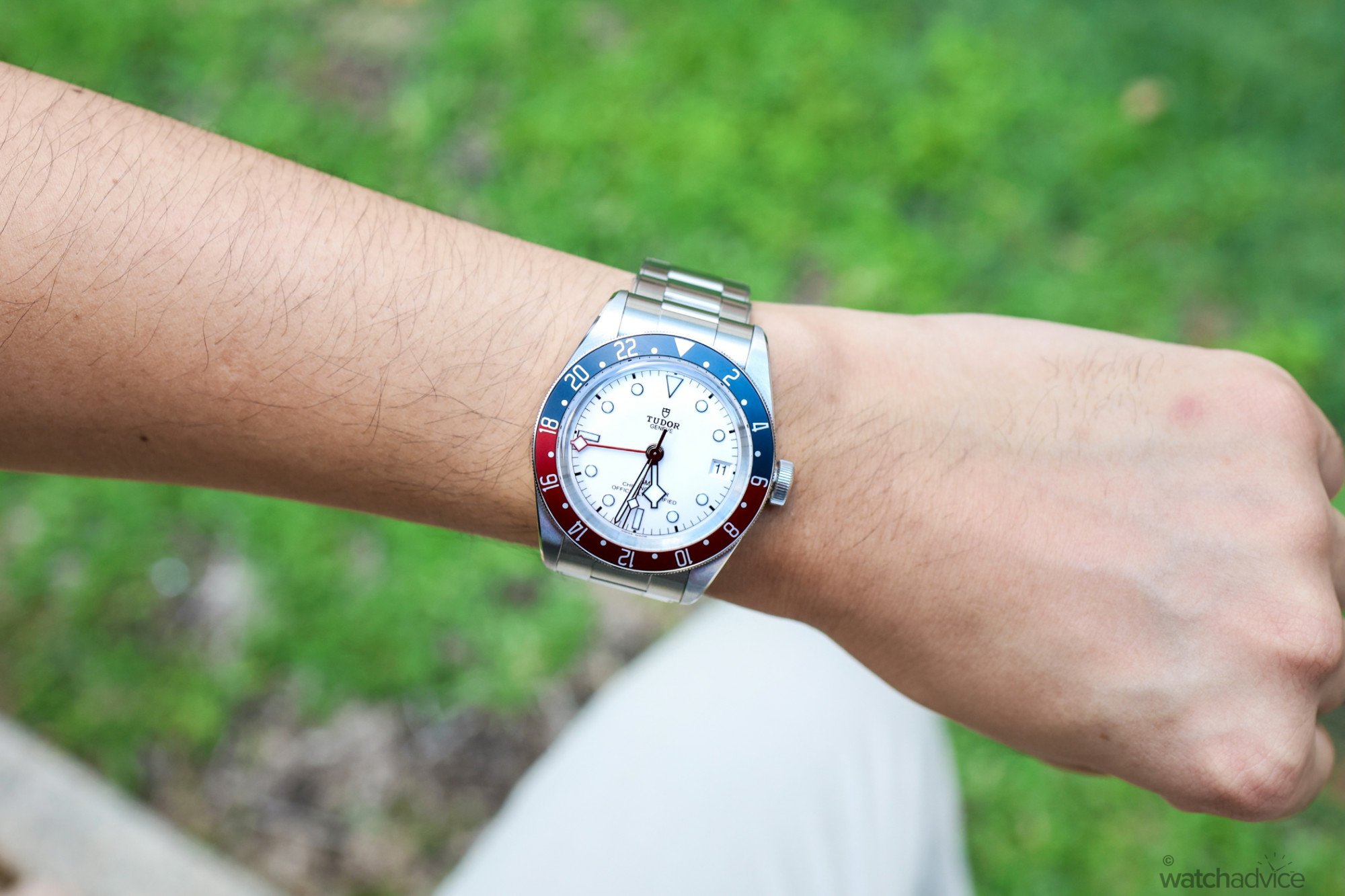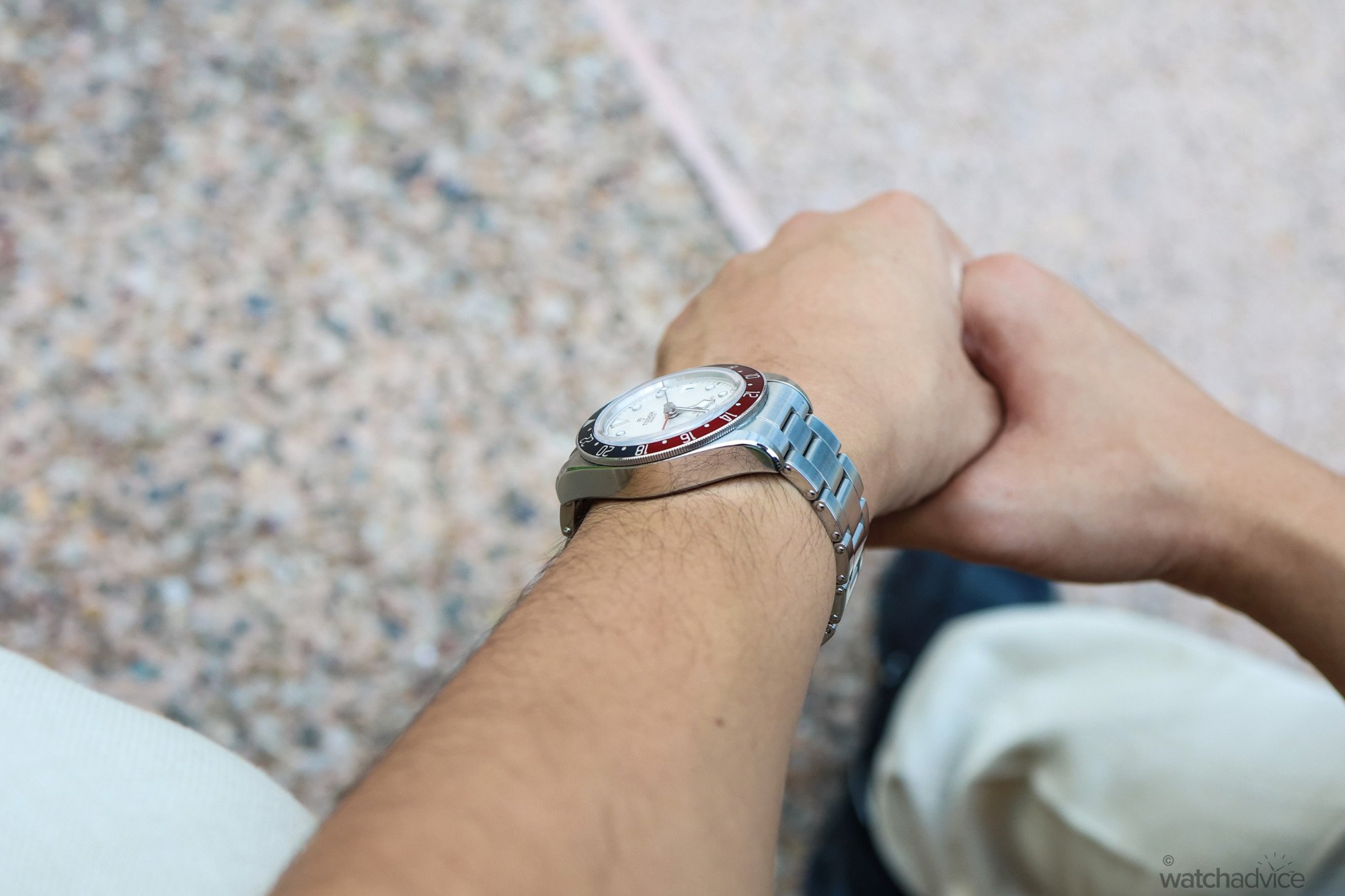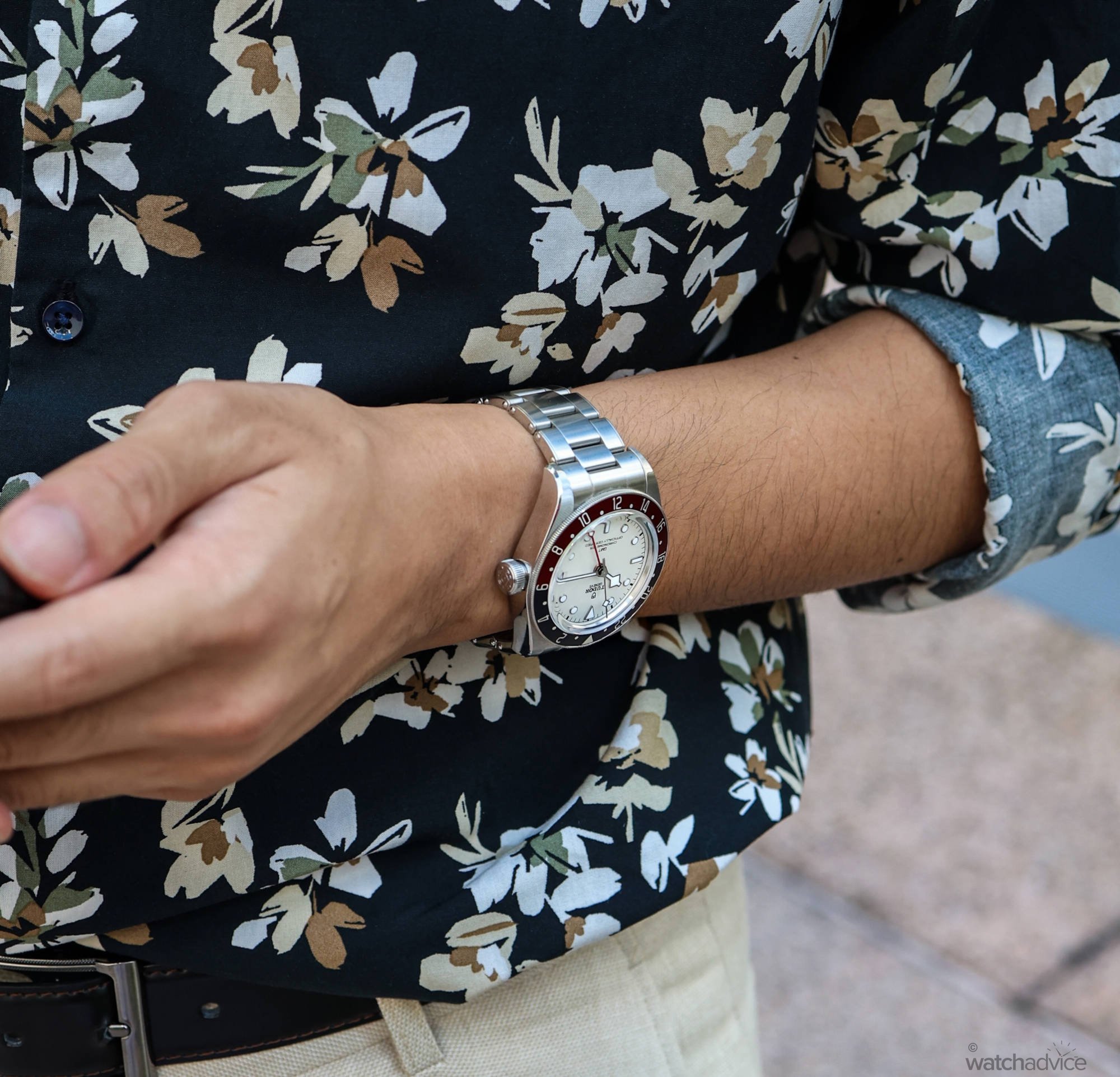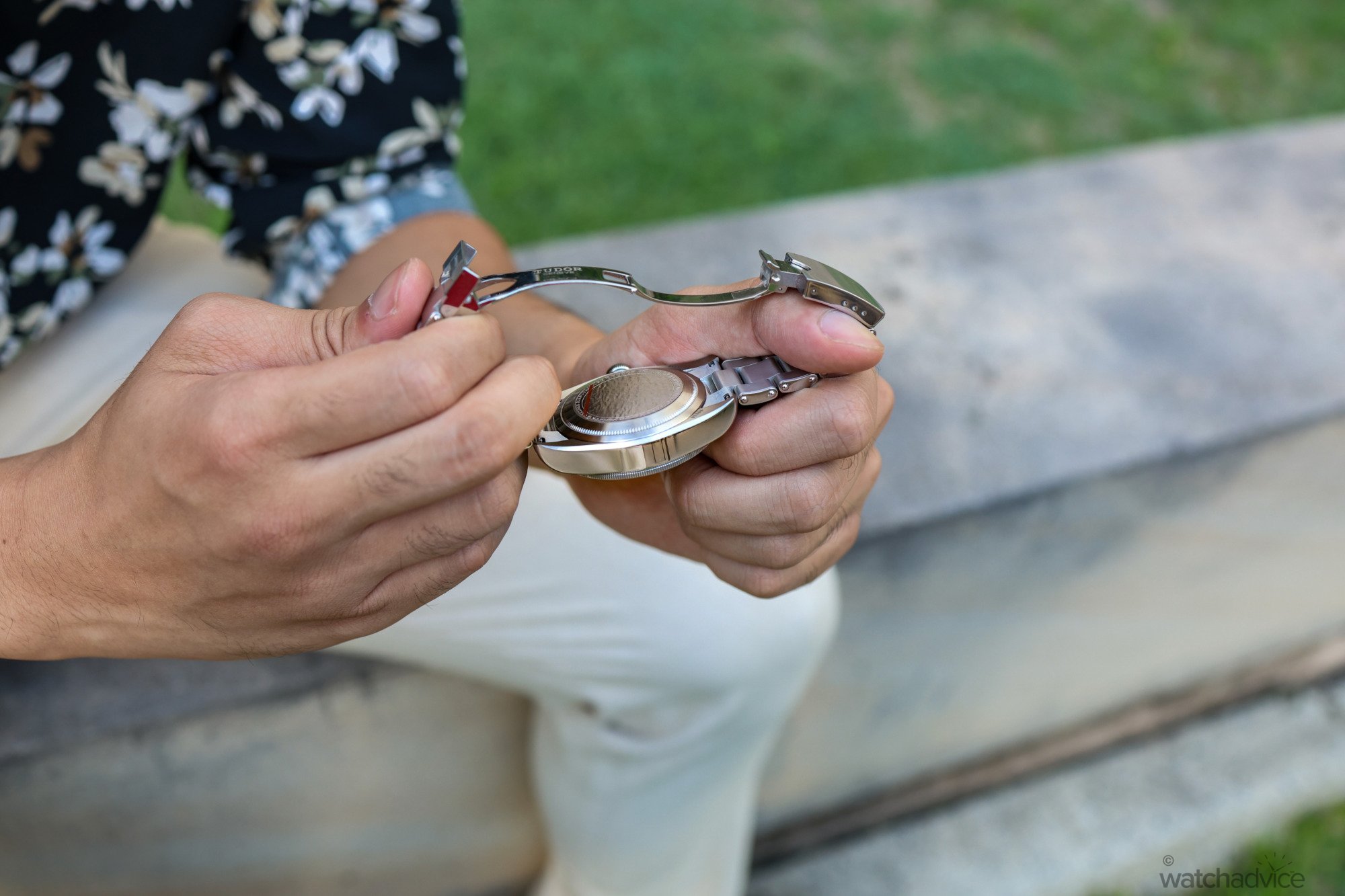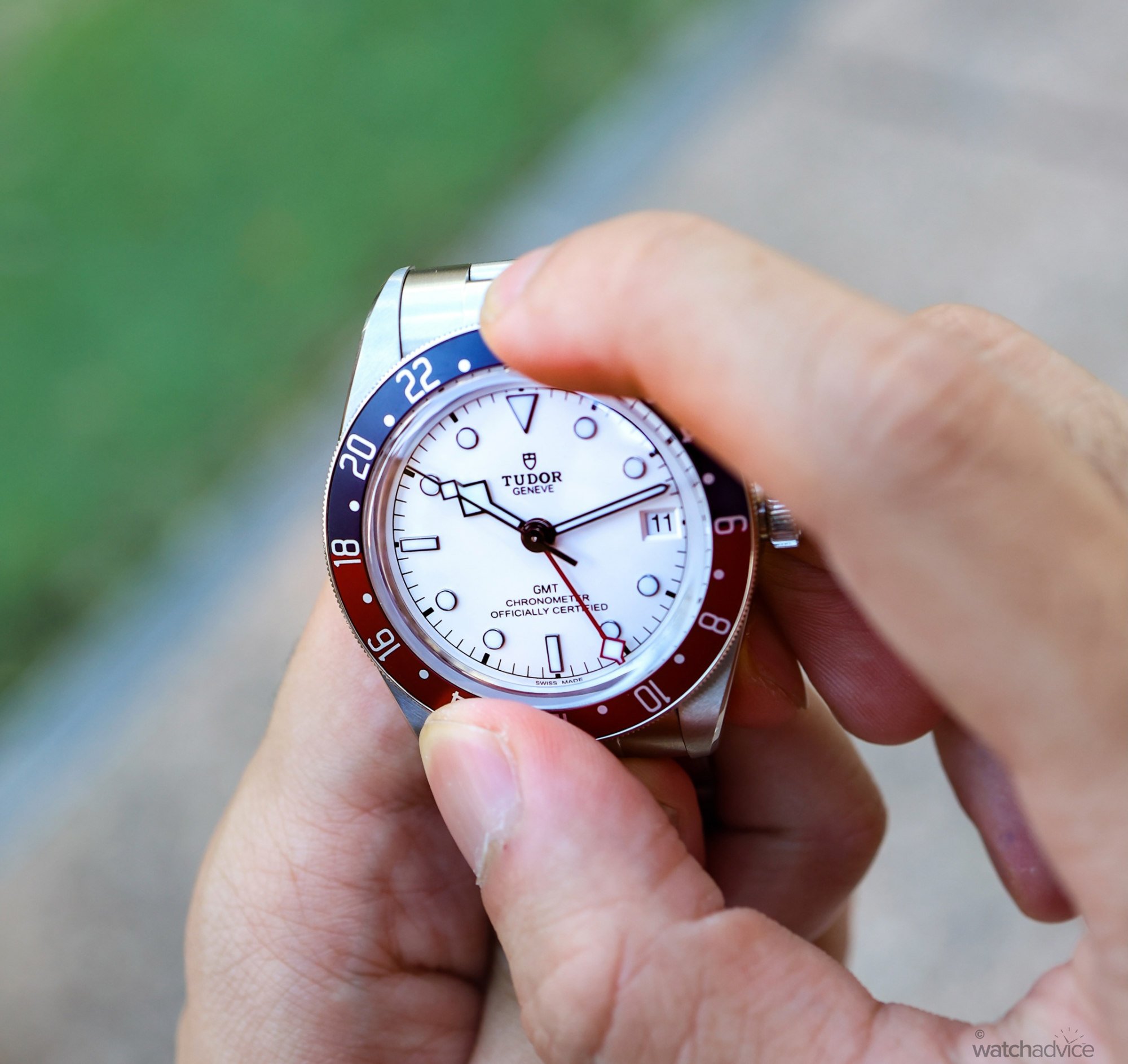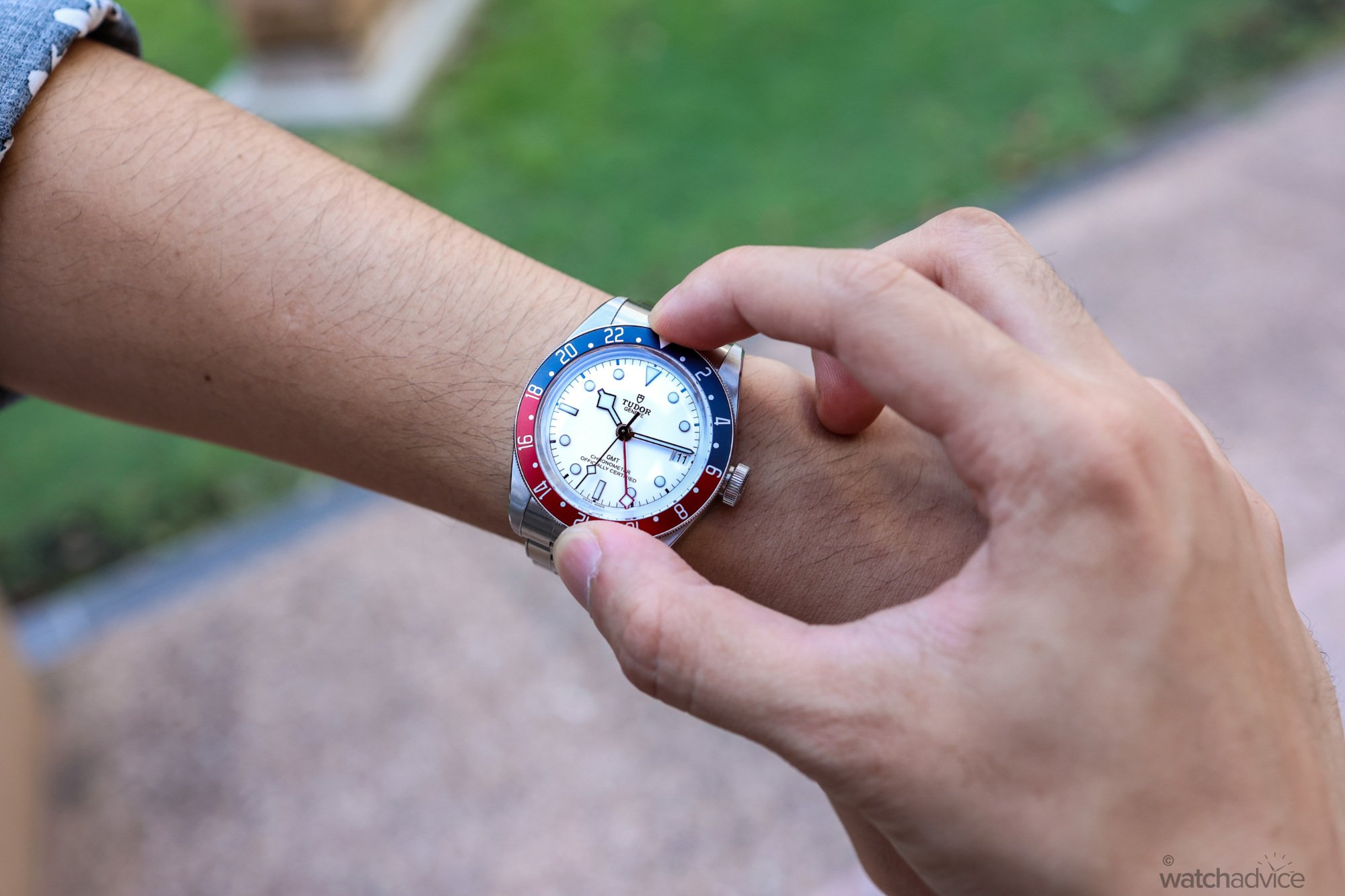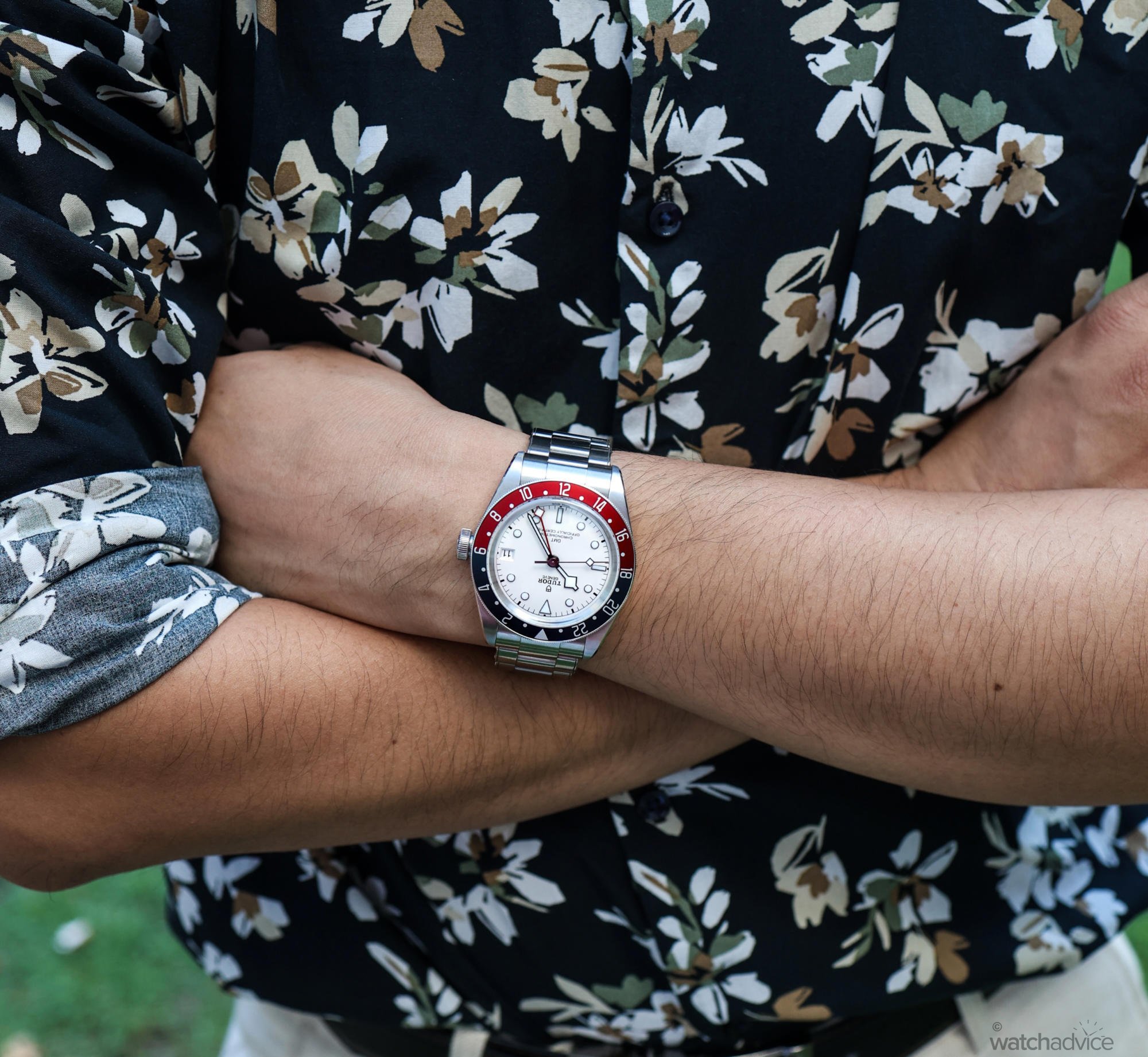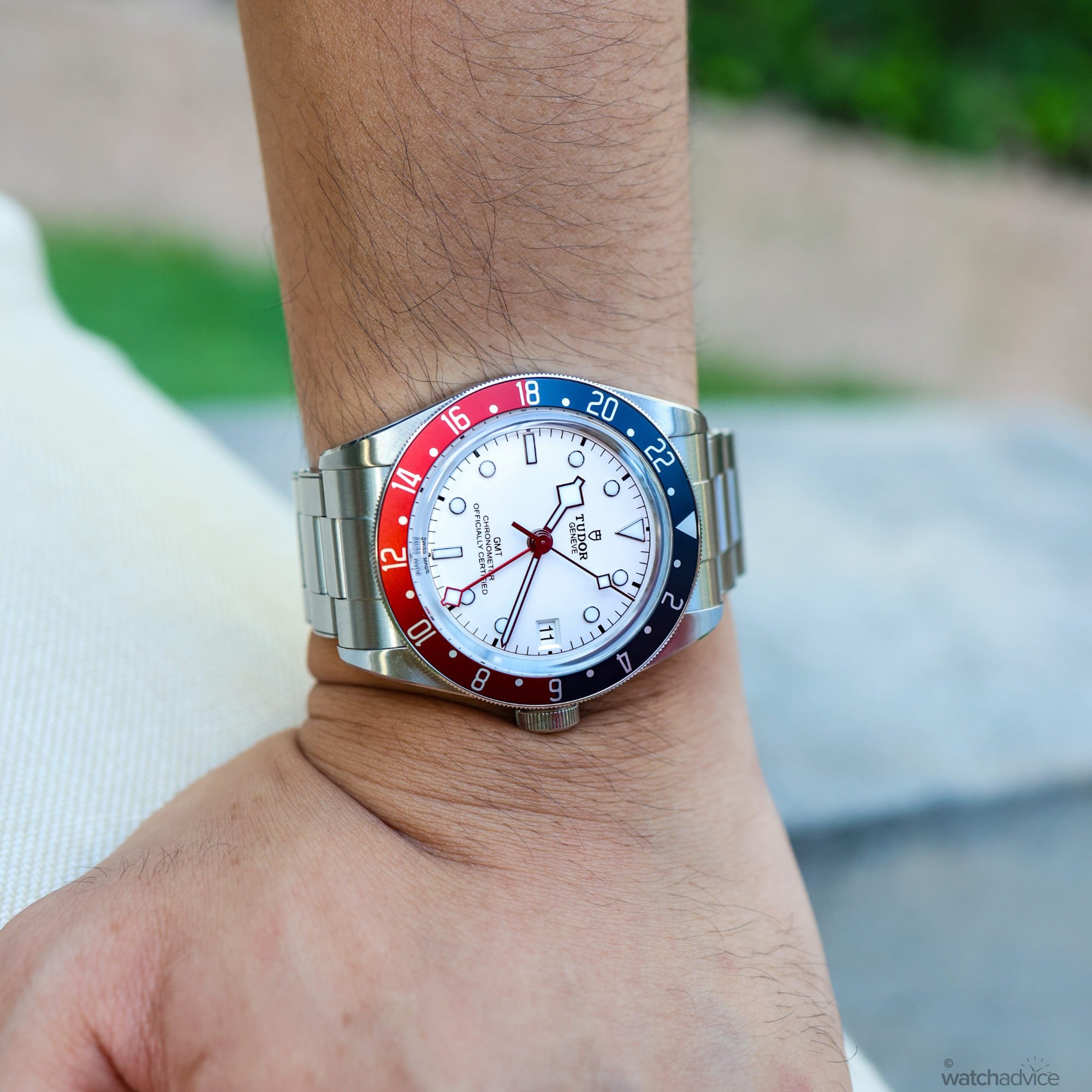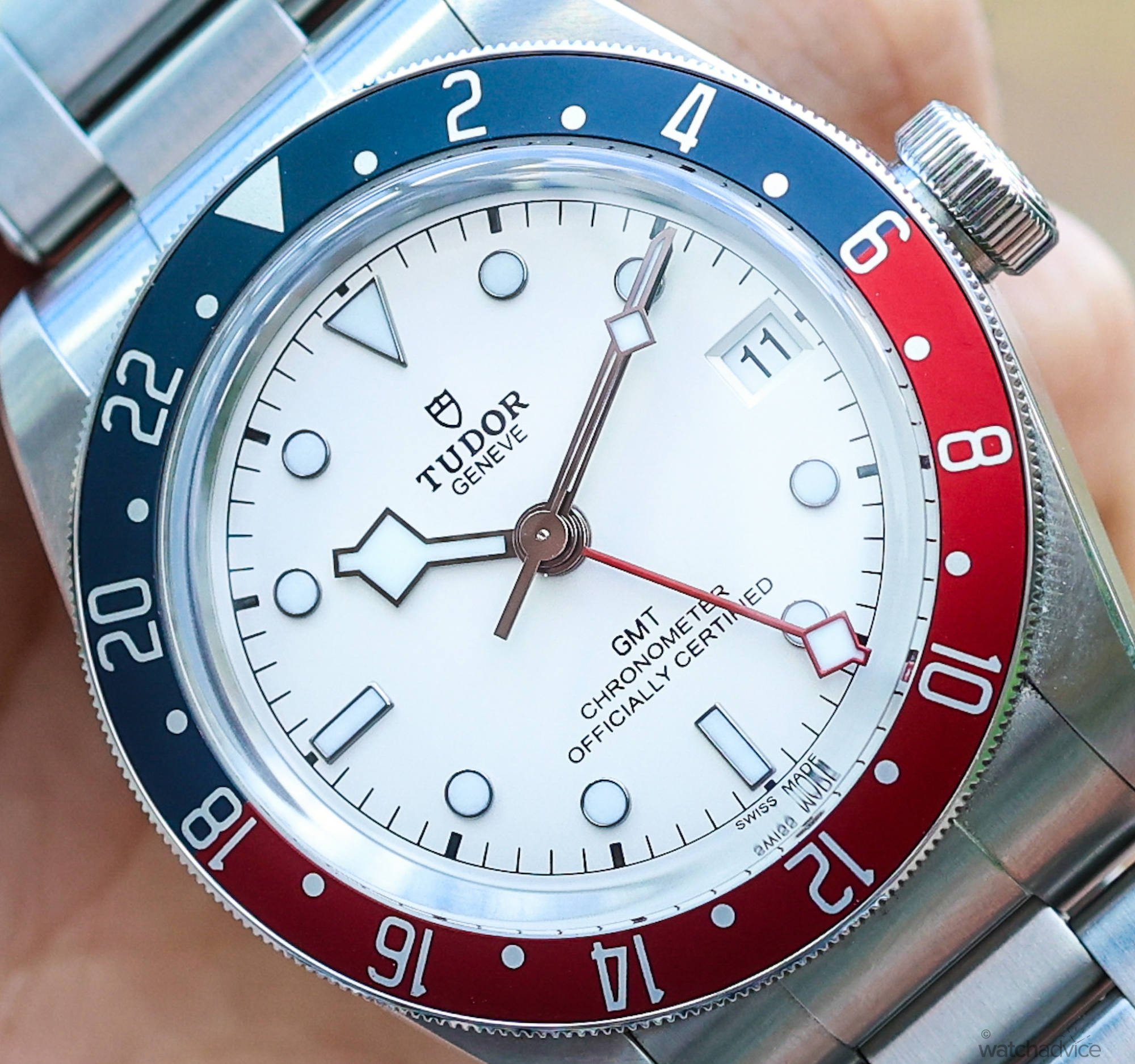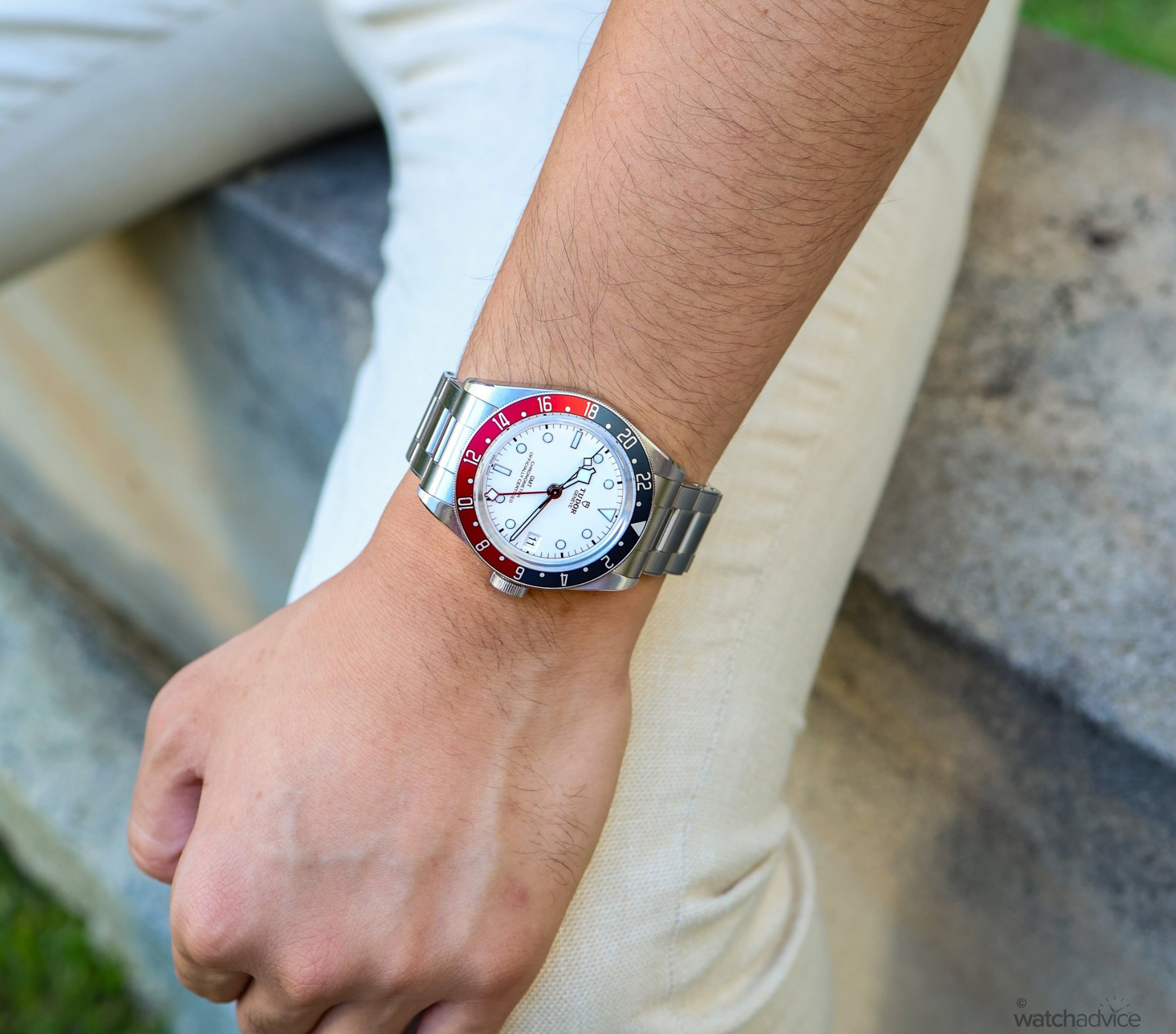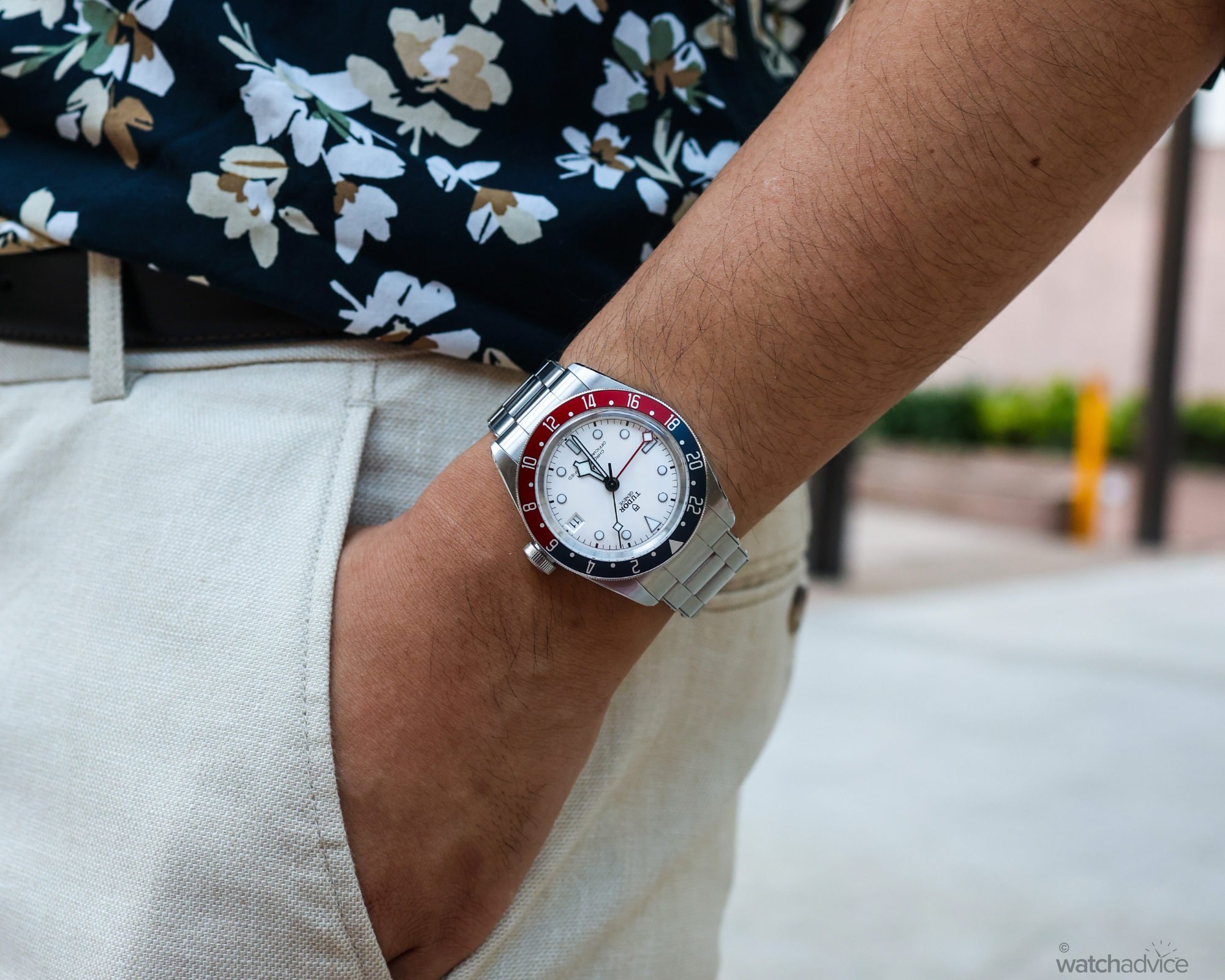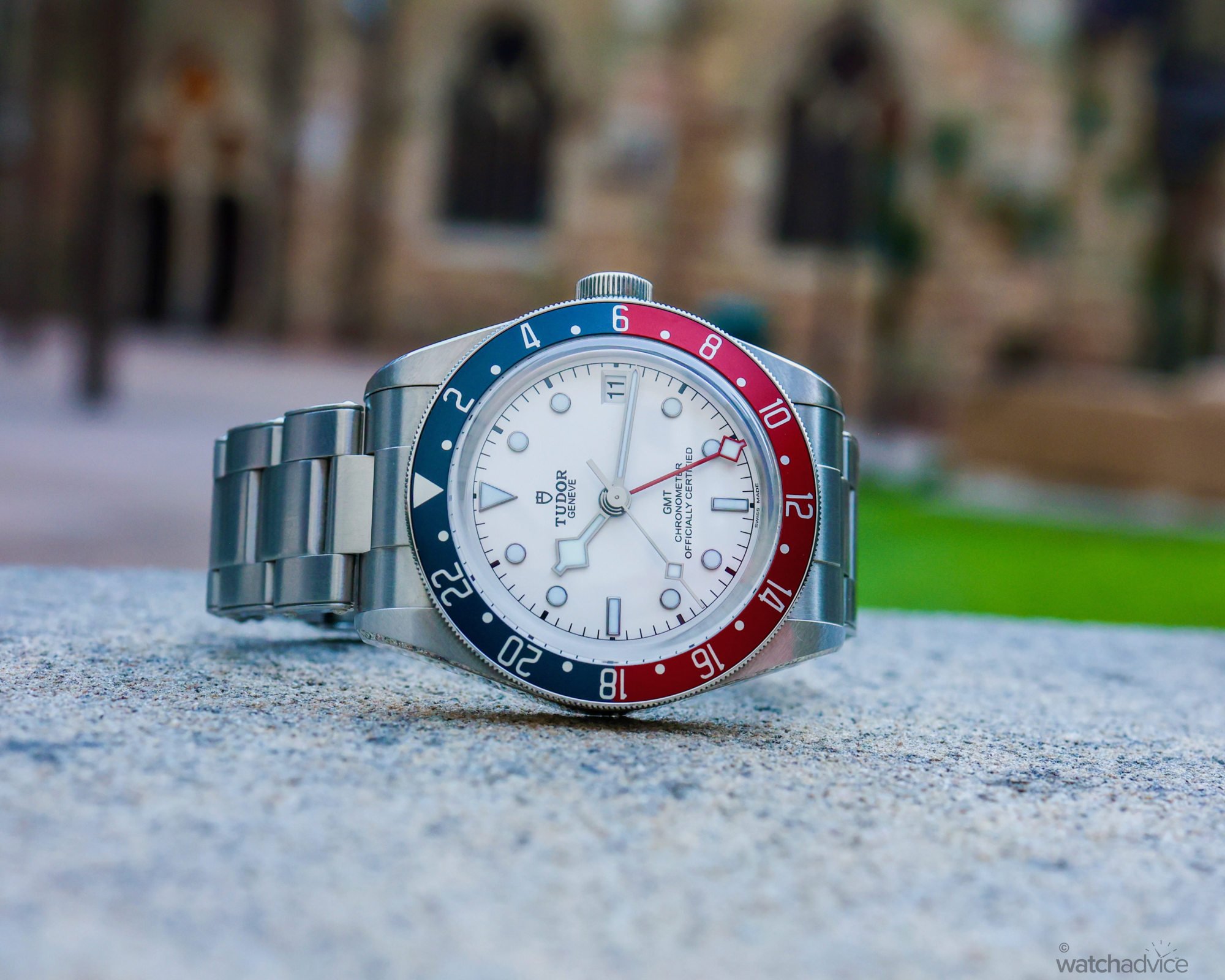What’s it like to own the Tudor Back Bay GMT Opaline Dial? And is it better than the original Black Bay GMT with the black dial? After spending half the year with mine, I know my answer!
Purchasing Expectations
- Loved the bulky aesthetic
- Wanted a traveller’s GMT that ticked all the boxes
- My first Swiss luxury watch brand
Ownership Reality
- Incredibly well-rounded and reliable; A true GADA timepiece
- Perhaps too bulky, almost unbalanced even on the bracelet
- Where is the in-clasp adjustment?
Overall Rating: 8.5/10
- Value for Money: 9/10
- Wearability: 7/10
- Design: 9/10
- Build Quality: 9/10
Taking the Pepsi Plunge
If you have just dipped your toes into the whirlpool that is the watch world, you would know the recognisable blue and red colours of the Rolex GMT-Master II, nicknamed “Pepsi.” You would also know that acquiring such a watch is – for want of a better phrase – a massive pain in the behind! To even get a chance at one, you must:
A) Know a guy who knows a guy, or
B) Play games with the Authorised Dealer for what can extend to an eternity, or
C) Fork over exorbitant amounts of money for instant gratification on the secondary market.
If you’re in the same financial situation as me, or even significantly wealthier, this kind of behaviour would put anyone off from trying to get one.
Even so, they are still incredibly popular – but that’s a whole different rabbit hole to go down.
So, when Tudor released the original Black Bay GMT at Baselworld in 2018, it became an overnight sensation. The prospect of getting a Rolex Pepsi at high build quality and a reasonable price caught the watch world by surprise. It didn’t take long for the Pepsi’s little brother to fly off the shelves at the boutiques. The fact that it launched alongside the steel rendition of the Rolex Pepsi made it even more appealing, as collectors at more tenable price points were able to join in on the fun.
But like anything, as time passed the excitement for the Black Bay GMT began to wear off. Tudor was slowly being written off as a “one-trick pony,” having relied on their Black Bay collection extensively since 2012. And while that phrase still somewhat rings true, in 2023 they would truly begin to show exactly why the Black Bay collection is so revered by collectors worldwide.
Watches & Wonders
Throughout my childhood as well as into some of my adult life, I had always been a massive nerd. I would stay up late at night to watch live gaming conventions, so I could see the big announcement trailers from my favourite videogame companies.
That same feeling of anticipation hit me at the commencement of Watches and Wonders 2023, where I for the first time immersed myself into the world of horology. I suppose my geeking out extended to watches as well as videogames; I was the same nerd – but the toys got a whole lot more expensive.
Early on in my horology journey, Tudor caught my eye as the lesser-known counterpart to their sister brand and industry GOAT, Rolex. I didn’t know much about them at the time, but I feel that my perception was skewed. Unfortunately, I caught wind of the annoyingly vocal minority of snobs in the watch community that would always cruelly refer to them as “poor man’s Rolex.”
Though this statement is somewhat founded in truth – Hans Wilsdorf had founded Tudor in 1926 as a reasonably-priced alternative to the Crown – referring to them as such now simply robs the brand of the incredible heritage and brand identity that they have been building for almost a century. Not to mention that referring to any watch as a “poor man’s” anything is just plain rude.
Impassioned rant aside, it was that underdog-style reputation that had piqued my interest in the brand, which only grew as time passed. This fascination came to a head in April, as Watches and Wonders commenced. To begin with, I saw the video announcements from the heavy hitters – Rolex, Cartier, and TAG Heuer all came out swinging. So far, so good.
But then, while browsing the web, I was recommended a video from the Tudor YouTube channel, announcing their new pieces for Watches and Wonders 2023. I must admit, the entire announcement played out like a videogame trailer, told from the perspective of one of the Tudor Manufacture’s robots, all to the beat of some dramatic music and lighting. Each watch was revealed through long, pregnant pauses in the music, just so the watcher could take it all in. My excitement grew as I watched on, but about 90 seconds in, I saw the watch I would soon call mine.
As the robot in the video says, “…this new Black Bay GMT, now with a new opaline dial. Opaline – not quite white, but sure is… stunning!” I was immediately enamoured. But I had never forked over this level of money for any timepiece before, so of course I was hesitant. I held off from going to the boutique for the time being.
But as my birthday rolled around, I knew I had to celebrate with something extraordinary. I had asked about the Opaline GMT many times, but every time they told me it was out of reach. Until one day, literally on the day of my birthday, I walked in, and they said they had just one available – one that wasn’t even on display.
At that moment, I didn’t care about any other watch. I didn’t care if they were lying to me and they had 20 more waiting and ready to go. As far as I was concerned, this was the one for me. One card swipe, AUD $6,090 (at the time), one excited friend, one jealous dad, and one disgruntled girlfriend later, and I became the proud owner of a Tudor Black Bay Opaline GMT.
On the (6.3in/16cm) Wrist
Even before making the purchase, what popped out to me initially was how big the watch looked and felt. The measurements were already pushing the limit on my wrist: 41mm case diameter with a 50mm lug-to-lug, but what got me was the 14.7mm thickness of the Opaline GMT. I’m already familiar with thick watches – my Orient Sun and Moon is 13mm thick – but I agree with what Matt said about his Tudor GMT: The slab sides do exaggerate the profile of this piece on-wrist.
This is also where I encountered my first issue – my wrist was so small that the salesperson had to take out almost every link for this monster to fit! Although a bit disappointing from a wearability end, I knew that in hotter temperatures my wrist would swell slightly to compensate for any looseness. So, I decided to go ahead despite it sliding a little up and down my wrist during winter – I didn’t mind if it felt a bit wonky. As I predicted, however, it wears quite well in the sweltering heat.
I can’t help but think that the solution has been staring Tudor in the face this entire time. The GMT collection has been around for about five years now, yet they still haven’t implemented the on-the-fly micro-adjustments for the clasp. The real kick in the behind is that the Black Bay Pro, another GMT released years prior, does have a micro-adjustment in the clasp, with Tudor’s new T-fit system! It’s evident that Tudor has the capabilities to distribute this, so it’s irksome to see them copy their sister brand relating to quality-of-life changes. I don’t want to, nor should I have to hype myself up for ‘innovations’ already considered to be a standard in the watch industry.
This isn’t the be-all, end-all of the Opaline GMT’s wearing capabilities though. Being a more accessible brand, Tudor has an alternative fabric strap option. While they do say that the fabric strap is “A key feature of the Tudor identity,” it’s still a very welcome change in contrast to the weightiness of the steel bracelet. It may help to lessen the weighty feel of the watch on the bracelet but does make the weight distribution rather top-heavy.
GMTs: “True” or False?
Powering the Tudor Black Bay Opaline GMT is the Kenissi-manufactured MT5652 movement. Yes, it’s the same one they put into the original GMT collection five years ago, but if you check out the specifications it becomes clear that Tudor realised that they don’t have to reinvent the wheel here. A COSC Certified Chronometer, 4Hz beat rate and a 70-hour power reserve are as reliable as it is accurate and having a flyer GMT is the icing on the cake. You can even track three time zones concurrently, thanks to the two-tone, bi-directional rotating bezel on the Opaline GMT, but it will take a lot of mental gymnastics to get the hang of it first.
For those who are not familiar with the term, we have an article to describe the difference between a flyer GMT and a caller GMT, but here’s a quick summary: A flyer GMT allows you to adjust the hour hand of your watch independently from your set home time, while a caller-style GMT adjusts the GMT hand to track a second time zone beyond your home time. However, many in the community often refer to the former as the “true” GMT, referring to the complication’s origin and intended purpose.
While this is no matter of its own, what gets me about this title is that some in the community exaggerate the modern-day necessity of a “True” GMT. This allays the novice collector’s enthusiasm for caller GMTs to believe that the flyer is superior, despite having no real use without travel. I assume those same novice collectors must have felt quite silly during the COVID times, having purchased a watch built for travel that was now grounded to the living room.
Sure, you can argue and scream about which GMT is the most necessary, but why would you? The reality is that it makes about as much sense to have a flyer GMT and not travel, as does globetrotting with a caller GMT. Any GMT watch, nor any watch in general, could even be considered ‘necessary’ anymore these days.
Despite not being strictly necessary, a flyer GMT complication is a welcome one. Not just to add complexity to a sophisticated piece (or person), but to provide a more tactile and interactive approach to travel. Being on a limited budget myself doesn’t exactly denote a jet-setting lifestyle, but I still enjoy the Opaline GMT, redundancies and all. It enhances the travelling experience and makes it that little bit more special – as opposed to just watching the time change on your smartphone as you get off the plane.
Honestly, it just depends on both your lifestyle and your preferences. If you aren’t travelling all that much, or work internationally for your company, a caller GMT would work best. If you’re a globetrotter or one that loves the journey almost as much as the destination, a flyer GMT like the Tudor Black Bay Opaline GMT would suit you.
The Six Thousand-Dollar Question
As stated at the beginning of this article, Matt had already reviewed this piece as part of his Owner’s Perspective. Furthermore, he also wrote the initial article on Watch Advice announcing the release of Tudor’s Opaline GMT. Before I begin tearing apart his hard work though, I’ll give my first impressions of the timepiece as I saw it firsthand.
Having not delved into plus-sized watch brands at the time (i.e. Panerai), I was blown away by how chunky the Opaline GMT was in person. It was robustly built, almost brutalist, but I feel the most appropriate description of the case silhouette is ‘tanklike.’ It’s as if Pepsi was about to go to war – They had finally had enough of Coke’s antics and invaded their headquarters, like how D-Generation X invaded WCW in ‘98.
Though they have been a point of contention for the Tudor bracelets ever since their introduction, I didn’t even mind the faux rivets. It adds another curved dimension to a predominantly linear timepiece, which furthers the militaristic and tough stature of the timepiece.
Polished bevelling on the case also makes it quite appealing to look at, despite the case and bracelet being predominantly brushed. Add in polished sides as well, and this piece can look somewhat elegant on most business/smart casual outfits like polos or button-ups.
The colour of the bezel and dial is where the watch truly shines – both figuratively and literally. The contrasting red and blue of the bezel feed tastefully into the opaline dial decorated with contrasting indexes.
This is the first point where Matt and I disagreed – Matt argued that as opposed to the dark dial Tudor Black Bay GMT (referred to as the “OG”), the contrast and legibility were insufficient for readability.
I can agree from looking at online photos of it, but when I see the watch in person, it isn’t like that at all. The Opaline GMT is not quite stark white, but a white-grey, which I enjoy as it contrasts with the lume and date window whilst providing a sense of totality and uniformity to the watch.
The hour marker surrounds, as with the snowflake hands, were all also noticeably darkened to provide further contrast to the watch. While the dark dial provides a more significant contrast, I believe that what Tudor has done on the Opaline GMT should be sufficient for most people. It could just be my youth talking, though, and perhaps I will be eating my words about dial legibility in the future. The amount of time that I’ve spent in front of screens is likely equivalent to staring at the sun for days on end!
The white dial also feels a lot less mature and freer than the black. Where you could wear the black dial at the beach or in the boardroom, I would say the Opaline GMT feels most at home with a linen shirt, on a yacht, and a glass of champagne in hand. It may not be as pricey as the rest of the pieces at the party, but it certainly looks the part.
Another point that Matt brought up in conversation is that the OG’s higher legibility is more representative of the diver’s watches of the era, and blending the dial with the other elements means deviating from the heritage of the piece.
Let me preface this by saying that I’m not one known to be kind with my collection. What helps to soften the blow of my watch purchases is always to remember that I bought them for a reason – to get my money’s worth. Even so, I love getting watches that have a distinct purpose in my collection, just to avoid doubling up and homogenising my preferences too soon. I have a diver to use in the water, and a GMT to use for travel. The styles and heritage can intertwine, but the purpose remains one per watch.
Again, I disagree with Matt – though the Tudor Black Bay has traditional diving roots, I believe a GMT is meant to stay above the waves. After all, you don’t care what time it is in another country when you’re 50 metres underwater.
The same goes for the date window. I know how much you love your date windows, Matt! Useful, but optional on a watch built for diving.
From my point of view, it doesn’t matter how true-to-form the OG Black Bay GMT is, I would consider it to be more of a sports watch than a diver. The addition of a fourth shade confuses my eyes, so even though it does sacrifice legibility on the dial, it adds a level of symmetry to the overall design. In turn, it even makes the bi-colour bezel pop a lot more. The sports watch/diver watch separation becomes even more apparent with the lack of a crown guard, which dissuades me from usage in the water lest I knock it around while swimming.
Finally, although it’s not relevant to my argument, showing my non-watch friends from the United States the Opaline GMT, only for them to reply with variations of “AMERICA!” kind of sealed the deal on this one for me. What’s not to love about a red, white & blue watch?
Final Thoughts
I’ve owned my Opaline GMT for about half the time that Matt has owned his OG GMT, which is understandable considering mine didn’t exist when he bought his. Despite this, I too have been able to put the Tudor through its paces. Does it still hold up in 2023? Does the increasing price point (now AUD$6,460) affect the Tudor’s value proposition?
I would say ‘Yes’ and ‘That Depends.’ Firstly, I concur with Matt’s opinion – this watch is solid, both literally and figuratively. The mechanics and general build quality are superb, and it wears well, but it can get a bit too much for those with more conservative tastes in watch sizing. For me, I am beginning to tend towards smaller watches, but that doesn’t mean I am deterred from the dimensions by any means. Of course, I worry, but once it’s on the wrist all of my objections slip away, and I am left to look with wonderment at the Opaline GMT as if it was the same day I bought it.
The Opaline GMT’s dial on a ‘Pepsi-like’ bezel is a new(ish) and welcome spin on an old classic. Sure, it may not be a faithful reinterpretation of what had once been, but sometimes nostalgia is almost too powerful. We should certainly celebrate the past, but why not also enjoy what you have in the present? The Opaline GMT is exemplary of this and has the design chops to do so – and then some.
Of course, the one question left to ask: “Is it still worth it?” If you have the money to get it, then sure! Tudor has always been one of the first brands mentioned when it comes to value in the realm of luxury Swiss watchmaking, and though the prices are creeping up little by little, at the time of speaking it is something worth pursuing.
I understand if the AUD$6,460 price tag makes you hesitate. Not everyone can pursue this type of luxury product without financial strife. So if this kind of watch is something you fantasise about but are unlikely to afford, there are always suitable alternatives around if you want to get in on the action. I highly recommend researching watches with the new Miyota 9075 movement in it – not in-house or COSC level, but it’s an entry-level, accessible flyer GMT. More specifically, I would advise looking into the Lorier Hyperion SII Skyward for the Pepsi aesthetic, or others like the Traska Venturer, Lip Nautic Ski GMT, Citizen Series 8 GMT and the Jack Mason Strat-O-Timer just to name a few.
To conclude, even in the present day, Tudor has proven to be one of the definitive leaders in value for luxury watchmaking. For those wishing to pursue a flyer “true” GMT, a luxurious daily driver, or just a stylish piece to add to the neverending collection, look no further than the Tudor Black Bay Opaline GMT.
Reference: M79830RB-0010
Specification
- Size: 41mm, 14mm thick, 50mm lug to lug
- Case: stainless steel case with polished and satin finish
- Bezel: 48-notch bidirectional rotating bezel in stainless steel with 24-hours graduated matt burgundy/blue anodised aluminium disc
- Crown: Screw-down crown, with the TUDOR rose in relief, with circular satin-brushed steel winding crown tube
- Dial: Domed black dial
- Crystal: Domed sapphire crystal
- Movement: Manufacture Calibre MT5652 (COSC), Self-winding mechanical movement with bidirectional rotor system. Anti-magnetic silicon balance spring, vibrating at 4Hz / 28,800 vph.
- Water Resistance: Waterproof to 200m (660 ft)
- Bracelet: Three-link stainless steel bracelet with polished and satin finish



